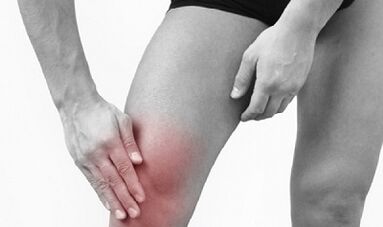
One of the most common pathologies of the musculoskeletal system is the arthrosis of the knee joint (otherwise gonarthrosis) is a chronic disease accompanied by dystrophy and destruction of the joint structures of the knee.
The result of destructive processes is a sharp restriction or complete loss of joint mobility and, as a result, a reduction in productivity, damage.
It is possible to prevent adverse effects only if you are diagnosed and therapy on time.
Reasons
By origin, knee arthrosis is primary and secondary.Primary develops as an independent disease, more often diagnosed in the elderly, and in this case it is due to changes related to the age occurring in the tissues.Secondary gonarthrosis is the result of other diseases and disorders in the body.
The development of gonarthrosis contributes to:
- Injuries (dislocations, fractures, meniscus damage);
- diseases of the musculoskeletal system (congenital deformity of the legs, knee dysplasia, chondrocalcinosis, arthritis, osteoporosis);
- constant high workloads of the joint part due to professional activities, professional sports;
- overweight, obesity;
- Endocrine diseases, including diabetes, hypothyroidism, acromigalia;
- metabolic disorders;
- Genetic predisposition.
Symptoms
Inflammation with knee arthrosis is accompanied by two main clinical manifestations - pain and edema.The intensity and frequency of pain depends on the depth of damage to the joint structures.At the initial stage, the pain is felt only with load, quickly passed at rest.With advanced gonarthrosis, pain is constantly hurting, increases during movements with a change in time.
Other signs of knee arthrosis joint:
- crunching on movement;
- Joint stiffness, disorder of motor function;
- Knee deformity (with neglected gonarthrosis).
Gonarthrosis may be accompanied by synovitis (fluid accumulation in the joint cavity) and the subsequent formation of a cyst of the cockroach (an elastic formation on the back of the knee).
Arthrosis
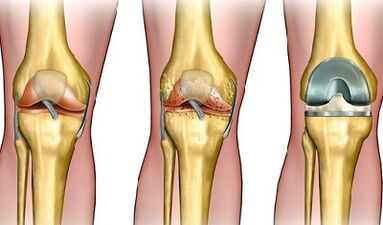
Symptoms of arthrosis of the knee joint vary depending on the depth of damage to the knee structures and therefore 3 stages of pathology are distinguished.
- Knee arthrosis joint 1 degreeIt is manifested by poor pain at loads (at rest passes at once), with slight stiffness after sleep.The radiographic picture indicates a slight narrowing of the joint gap (less than one third), notes the presence of single osteophytes (bone growths).
- Knee arthrosis joint 2 degreesIt is accompanied by pain and a characteristic crisis during movements.The pain lasts for some time at rest.Morning stiffness, limiting the amplitude of movements is noted.Diagnostic procedures reveal a pronounced narrowing of the joint gap (more than half) and multiple osteophytes.
- Knee arthrosis 3 degreesIt is accompanied by constant pain in the pain, which during movements and at night intensifies.The morning stiffness remains longer than an hour with exacerbation of inflammation and at least half an hour - during periods of remission.The joint mobility is sharply restricted or completely lost.The radiographic picture shows many large osteophytes, cysts.The joint gap is narrowed by more than two -thirds of normal.
Depending on the degree of arthrosis of the knee joint, the patient is prescribed conservative or surgical treatment.
Diagnostics
The diagnosis of knee arthrosis includes a visual examination, an analysis of the patient's complaints, laboratory tests (urine analysis, general and biochemical blood tests) and instrumental examination methods.
The following diagnostic procedures allow you to confirm or disprove the diagnosis:

- Radiography;
- Ultrasound (ultrasound);
- MRI (magnetic resonance);
- CT (computed tomography);
- Arthroscopy and scintigraphy (with a tumor suspected).
Using these methods, it is possible to detect the narrowing of the joints of the joints, the degree of thinning and deformation of the cartilage, the presence of fluid in the joint cavity, the structural changes in the synovial membrane, the growth of osteoophyte and the outbreaks of cartilage.
Conservative treatment
Conservative methods of treatment can reduce pain and inflammation, improve blood circulation and nutrition of periastic tissues, and enhance muscle apparatus.
For this purpose they behave:
- drug therapy;
- blockade;
- physiotherapy and manual therapy;
- Medical physical education.
An important component of the treatment of arthrosis is adherence to a therapeutic diet.
The conservative treatment of knee arthrosis will be effective in the initial stage of the disease, when minor dystrophic cartilage cartridges, inflammation and impaired function of the synovial sheath are noted.
Medication
Drug treatment includes the meeting:
- non -steroidal anti -inflammatory drugs (NSAIDs);
- chondroprotectors;
- Hyaluronic acid.
Nsaid
No -gossip anti -inflammatory drugs help relieve inflammation, reduce its main symptoms -ecosus and pain.
The preparations are prescribed in the form of solutions (for intramuscular administration) or tablets, capsules (for oral administration).Capsules and tablets of arthrosis of the knee joint of the NSAIDs group are taken in short courses, as medicines have a strong irritant effect on the gastric mucosa and can cause the development of peptic ulcer to have many other side effects.
In addition, prescribed external drugs (ointments, gels, creams) based on non -steroidal anti -inflammatory components.Local therapy is allowed to be performed in a long time.
NSAIDs have a pronounced anti -inflammatory effect, but with prolonged use contribute to the more increasing destruction of cartilage.
NSAIDs are symptomatic therapy.They help to eliminate the unpleasant symptoms of the disease, but do not affect the condition of the cartilage.Unlike these products, chondroprotectors and hyaluronic acid accelerate the processes of cartilage regeneration and slow down its destruction.
Chondroprotectors
The drugs of the chondroprotectors group contain chondroitin and glucosamine (structural elements of cartilage) and help to restore knee with arthrosis of the knee joint.They are available in the form of tablets, powder for oral administration, solution for injection.
The minimum course of tablet and powder is 3 months.After rest, the course is repeated 2-3 times.The course of solution treatment includes 12-15 injections, repeated 2-3 times a year.
The first positive results of chondroprotectors treatment are noticed only a few months after the onset of therapy.
Hyaluronic acid
Hyaluronic acid is introduced injected into the affected joint.Knee arthrosis is the role of lubrication - enveloping the joints, thus reducing the friction between them.
Hyaluronic acid therapeutic drugs help to increase the elasticity of cartilage tissue, prevents more destruction of joint structures, which improves joint mobility, the symptoms of inflammation are reduced.Medicines are well tolerated, do not cause side effects.Their only drawback is the high price.
The course of treatment with hyaluronic acid usually includes 3-4 injections that are performed with 10-14 days breaks.
Blockade
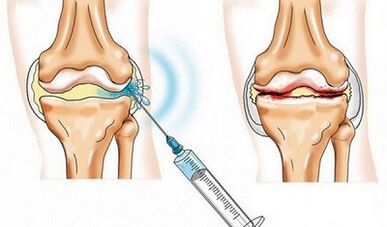
If with non -steroidal anti -inflammatory drugs it is not possible to relieve knee pain with arthrosis, a blockade -method of treatment is performed in which the medicines are injected directly into the affected tissues to relieve pain and inflammation.In arthrosis therapy, article (injections in the joint cavity) and periarticular (in the periarticular cavity) are used.
The main advantage of the method is an immediate purposeful action, since with such an introduction the maximum concentration of the active substance is created precisely in the area of inflammation.In addition, medicines do not fall into the systemic bloodstream, which significantly reduces the risk of side effects.
In the short stages of gonarthrosis, joint gaps narrow, osteophytes grow, joint surfaces deform, therefore only pericular blockage is allowed.
The blockade of the knee joint for arthrosis can be performed with the help of anesthetics and corticosteroids.
Anesthetics are usually introduced in combination with steroid hormones to reduce the pain of the procedure.
Hyaluronic acid and chondroprotectors can also be introduced directly into the joint.But in this case we are not talking about the blockade, but about an internal -articular injection, since these drugs do not block the impulses of pain, but cause the processes of regeneration of cartilage tissue.
Physiotherapy and manual therapy
The main methods of physiotherapy effects used in the treatment of arthrosis include:
- laser treatment;
- ultrasound therapy;
- cryotherapy;
- paraffin and ozocket therapy;
- Mud.
The main task of all physiotherapy procedures is to stimulate blood circulation in nearby tissues, to improve cartilage nutrition.
Exercise therapy
Pain syndrome forces a patient with gonarthrosis to limit motor activity, resulting in the atrophies of nearby relationships and muscles.This condition has a negative effect on the tissues of the joints, because during movement the nutrients penetrate from the synovial fluid into the cartilage.If the joint is constant at rest, the dystrophic processes deteriorate.
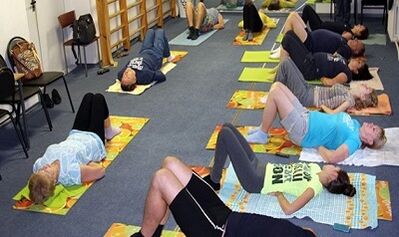
Therefore, physiotherapy exercises are an integral component of conservative therapy.Moderate physical activity allows you to strengthen muscle apparatus, strengthen the strength of joint structures, eliminate stiffness and improve the motor function of the knee.
Exercises of therapeutic exercises are developed by the doctor separately for each patient, taking into account the depth of the lesion and the functional condition of the joint structures.
General Recommendations for conducting exercises for knee arthrosis joint:
- Start classes only after stopping signs of acute inflammation;
- Perform all the exercises seamlessly, without sudden movements;
- The load increases gradually;
- Eliminate high joint loads (increased flexion/knee lengthening);
- If pain or discomfort occurs, stop training.
Diet
With gonarthrosis, products containing: containing:
- amino acids (dairy products, low fat varieties);
- collagen (dishes with gelatin);
- essential fatty acids (vegetable oils, fish);
- Sulfur and selenium (legumes, cereals, cabbage and apples, beef, chicken, eggs).
It is also important:
- Eliminate the use of smoked meats, pickles, marinades;
- limiting salt consumption;
- Stick to a 5-time diet;
- Observe the drinking mode.
Excess body weight is one of the main factors that provoke the development of knee arthrosis.Therefore, the task of patients with excess weight is to reduce body weight.In this case, you can only achieve the result with the help of a diet, as intense sports are harmful to the inflamed joint.
In order to reduce body weight, it is recommended to exclude from the menu:
- oily varieties of meat and fish;
- cream, homemade sour cream and other dairy products with a high fat content;
- Margarine, mayonnaise, various sauces;
- confectionery;
- fast food;
- Sweet drinks.
Surgical treatment
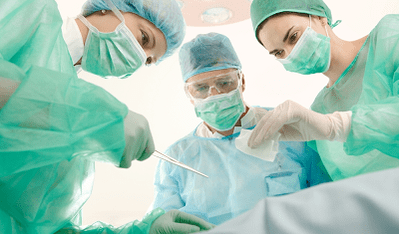
The arthrosis of the knee joint of the 3rd degree is not subject to conservative therapy, so surgery is the only outcome for the patient.
There are two options for surgery:
- Corrective osteotomy- is carried out in the initial stage of development of the 3rd stage of gonarthrosis, if the cartilage is partially destroyed, it is possible to remove osteophytes;
- Endoprothetics- The replacement of the joint or its destroyed parts is performed with the complete destruction of the cartilage.
Forecast
Pathological changes in joint structures are progressive, irreversible.However, with early diagnosis and proper treatment, you can completely stop inflammation and stop dystrophic changes in cartilage tissue - knee arthrosis is first amenable to conservative therapy.
With a degree of arthrosis, which is accompanied by the destruction of cartilage and the formation of osteophytes, conservative methods allow you to slow down or stop deformation of cartilage, stop inflammation and improve motor activity.However, doctors are often forced to resort to blockade, arthroscopy.
It is impossible to cure knee arthrosis of 3 degrees in a conservative way.The only way to restore knee mobility is surgery.

























